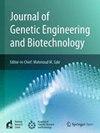以γ修饰PNA为模型的基因编辑:HBB基因
IF 2.8
Q3 Biochemistry, Genetics and Molecular Biology
Journal of Genetic Engineering and Biotechnology
Pub Date : 2025-09-25
DOI:10.1016/j.jgeb.2025.100562
引用次数: 0
摘要
PNAs已成为基因编辑的强大工具,特别是通过增强靶向重组和基因组修饰来纠正单基因疾病。本研究旨在在我们的基因组设施中建立一种使用肽核酸(PNA)/供体dna负载聚乳酸-羟基乙酸(PLGA)纳米颗粒的基因编辑技术,最终目标是纠正致病突变。方法包括在两个独立的12孔板中培养来自健康的埃及志愿者的无HBB基因突变的皮肤成纤维细胞。设计了寡核苷酸,制备了纳米颗粒并进行了表征,然后将其用于培养成纤维细胞。从处理过的细胞中提取DNA和RNA,然后进行分子分析以确认编辑。结果表明,纳米颗粒的成功包封和适度的、持续的引入所需的突变,伴随着HBB基因表达的功能损伤。该研究成功建立了PNA基因编辑技术,可能为未来单基因疾病的治疗研究铺平道路。本文章由计算机程序翻译,如有差异,请以英文原文为准。

Gene editing using gamma modified PNA: HBB gene as a model
PNAs have emerged as a powerful tool in gene editing, particularly for correcting monogenic disorders by enhancing targeted recombination and genomic modifications. This study aimed to establish a gene editing technique using Peptide Nucleic Acid (PNA)/donor DNA-loaded poly lactic-co-glycolic acid (PLGA) nanoparticles at our genomic facilities, with the ultimate goal of correcting disease-causing mutations. Methods involved culturing skin fibroblasts from a healthy Egyptian volunteer without HBB gene mutations in two separate 12-well plates. Oligonucleotides were designed, and nanoparticles were formulated and characterized before being used to treat the cultured fibroblasts. DNA and RNA were extracted from treated cells, followed by molecular analyses to confirm the edits. Results indicated successful encapsulation of nanoparticles and modest, sustained introduction of the desired mutation, accompanied by functional impairment in HBB gene expression. The study successfully established PNA gene editing technology, potentially paving the way for future treatment studies of single-gene disorders.
求助全文
通过发布文献求助,成功后即可免费获取论文全文。
去求助
来源期刊

Journal of Genetic Engineering and Biotechnology
Biochemistry, Genetics and Molecular Biology-Biotechnology
CiteScore
5.70
自引率
5.70%
发文量
159
审稿时长
16 weeks
期刊介绍:
Journal of genetic engineering and biotechnology is devoted to rapid publication of full-length research papers that leads to significant contribution in advancing knowledge in genetic engineering and biotechnology and provide novel perspectives in this research area. JGEB includes all major themes related to genetic engineering and recombinant DNA. The area of interest of JGEB includes but not restricted to: •Plant genetics •Animal genetics •Bacterial enzymes •Agricultural Biotechnology, •Biochemistry, •Biophysics, •Bioinformatics, •Environmental Biotechnology, •Industrial Biotechnology, •Microbial biotechnology, •Medical Biotechnology, •Bioenergy, Biosafety, •Biosecurity, •Bioethics, •GMOS, •Genomic, •Proteomic JGEB accepts
 求助内容:
求助内容: 应助结果提醒方式:
应助结果提醒方式:


